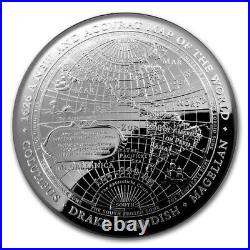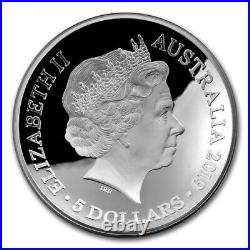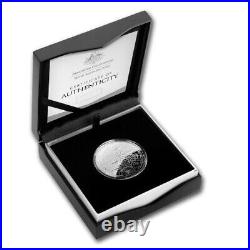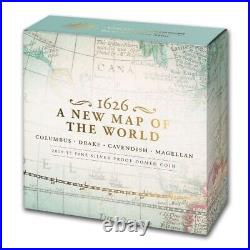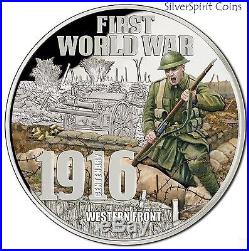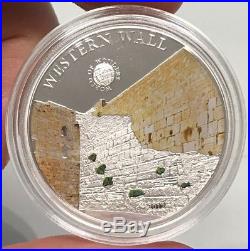
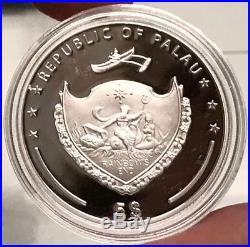
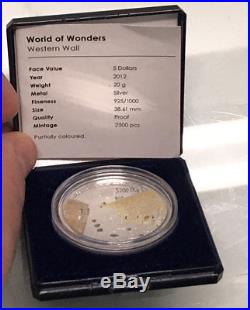
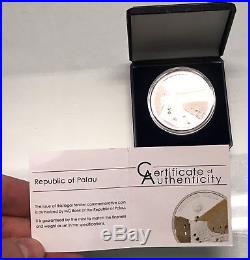
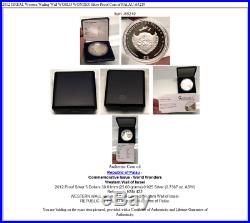

Item: i65219 Authentic Coin of. Commemorative Issue – World Wonders Western Wall of Israel 2012 Proof Silver 5 Dollars 38.61mm (25.00 grams) 0.925 Silver 0.7387 oz. ASW Reference: KM# 422 WESTERN WALL above partially colored Western Wall of Israel. REPUBLIC OF PALAU above coat-of-arms of Palau. Palau (, historically Belau or Pelew), officially the Republic of Palau (Palauan: Beluu er a Belau), is an island country located in the western Pacific Ocean. The country contains approximately 340 islands, forming the western chain of the Caroline Islands in Micronesia, and has an area of 466 square kilometers (180 sq mi). The most populous island is Koror. The capital Ngerulmud is located on the nearby island of Babeldaob, in Melekeok State. Palau shares maritime boundaries with Indonesia, the Philippines, and the Federated States of Micronesia. The country was originally settled approximately 3,000 years ago by migrants from the Philippines and sustained a Negrito population until around 900 years ago. The islands were first explored by Europeans in the 16th century, and were made part of the Spanish East Indies in 1574. The Imperial Japanese Navy conquered Palau during World War I, and the islands were later made a part of the Japanese-ruled South Pacific Mandate by the League of Nations. During World War II, skirmishes, including the major Battle of Peleliu, were fought between American and Japanese troops as part of the Mariana and Palau Islands campaign. Along with other Pacific Islands, Palau was made a part of the United States-governed Trust Territory of the Pacific Islands in 1947. Having voted against joining the Federated States of Micronesia in 1979, the islands gained full sovereignty in 1994 under a Compact of Free Association with the United States. Politically, Palau is a presidential republic in free association with the United States, which provides defense, funding, and access to social services. Legislative power is concentrated in the bicameral Palau National Congress. Palau’s economy is based mainly on tourism, subsistence agriculture and fishing, with a significant portion of gross national product (GNP) derived from foreign aid. The country uses the United States dollar as its currency. The islands’ culture mixes Micronesian, Melanesian, Asian, and Western elements. Ethnic Palauans, the majority of the population, are of mixed Micronesian, Melanesian, and Austronesian descent. A smaller proportion of the population is descended from Japanese and Filipino settlers. The country’s two official languages are Palauan (a member of the wider Sunda-Sulawesi language group) and English, with Japanese, Sonsorolese, and Tobian recognized as regional languages. The Western Wall , Wailing Wall or Kotel Hebrew: (help·info), translit. HaKotel HaMa’aravi ; Ashkenazic pronunciation: HaKosel HaMa’arovi ; Arabic: , translit. The Buraq Wall, or Arabic: al-Mabk : the Place of Weeping is an ancient limestone wall in the Old City of Jerusalem. It is a relatively small segment of a far longer ancient retaining wall, known also in its entirety as the “Western Wall”. The wall was originally erected as part of the expansion of the Second Jewish Temple begun by Herod the Great, which resulted in the encasement of the natural, steep hill known to Jews and Christians as the Temple Mount, in a large rectangular structure topped by a huge flat platform, thus creating more space for the Temple itself and its auxiliary buildings. The Western Wall is considered holy due to its connection to the Temple Mount. Because of the Temple Mount entry restrictions, the Wall is the holiest place where Jews are permitted to pray, though it is not the holiest site in the Jewish faith, which lies behind it. The original, natural and irregular-shaped Temple Mount was gradually extended to allow for an ever-larger Temple compound to be built at its top. This process was finalised by Herod, who enclosed the Mount with an almost rectangular set of retaining walls, built to support extensive substructures and earth fills needed to give the natural hill a geometrically regular shape. On top of this box-like structure Herod built a vast paved esplanade which surrounded the Temple. Of the four retaining walls, the western one is considered to be closest to the former Temple, which makes it the most sacred site recognised by Judaism outside the former Temple Mount esplanade. Just over half the wall’s total height, including its 17 courses located below street level, dates from the end of the Second Temple period, and is commonly believed to have been built around 19 BCE by Herod the Great, although recent excavations indicate that the work was not finished by the time Herod died in 4 BCE. The very large stone blocks of the lower courses are Herodian, the courses of medium-sized stones above them were added during the Umayyad era, while the small stones of the uppermost courses are of more recent date, especially from the Ottoman period. The term Western Wall and its variations are mostly used in a narrow sense for the section traditionally used by Jews for prayer, and it has also been called the “Wailing Wall”, referring to the practice of Jews weeping at the site over the destruction of the Temples. During the period of Christian Roman rule over Jerusalem ca. 324-638, Jews were completely barred from Jerusalem except to attend Tisha be-Av, the day of national mourning for the Temples, and on this day the Jews would weep at their holy places. The term “Wailing Wall” was thus almost exclusively used by Christians, and was revived in the period of non-Jewish control between the establishment of British Rule in 1920 and the Six-Day War in 1967. The term “Wailing Wall” is not used by Jews, and increasingly not by many others who consider it derogatory. In a broader sense, “Western Wall” can refer to the entire 488-metre-long 1,601 ft. Retaining wall on the western side of the Temple Mount. The classic portion now faces a large plaza in the Jewish Quarter, near the southwestern corner of the Temple Mount, while the rest of the wall is concealed behind structures in the Muslim Quarter, with the small exception of a 25 ft (8 m) section, the so-called Little Western Wall. The segment of the Western retaining wall traditionally used for Jewish liturgy, known as the “Western Wall”, derives its particular importance to it having never been fully obscured by medieval buildings, and displaying much more of the original Herodian stonework than the “Little Western Wall”. In religious terms, the “Little Western Wall” is presumed to be even closer to the Holy of Holies and thus to the “presence of God” (Shechina), and the underground Warren’s Gate, which has been out of reach since the 12th century, even more so. Whilst the wall was considered Muslim property as an integral part of the Haram esh-Sharif and waqf property of the Moroccan Quarter, a right of Jewish prayer and pilgrimage existed as part of the Status Quo. The earliest source mentioning this specific site as a place of worship is from the 16th century. The previous sites used by Jews for mourning the destruction of the Temple, during periods when access to the city was prohibited to them, lay to the east, on the Mount of Olives and in the Kidron Valley below it. With the rise of the Zionist movement in the early 20th century, the wall became a source of friction between the Jewish and Muslim communities, the latter being worried that the wall could be used to further Jewish claims to the Temple Mount and thus Jerusalem. During this period outbreaks of violence at the foot of the wall became commonplace, with a particularly deadly riot in 1929 in which 133 Jews were killed and 339 injured. After the 1948 Arab-Israeli War the Eastern portion of Jerusalem was occupied by Jordan. Under Jordanian control Jews were completely expelled from the Old City including the Jewish quarter, and Jews were barred from entering the Old City for 19 years, effectively banning Jewish prayer at the site of the Western Wall. This period ended on June 10, 1967, when Israel gained control of the site following the Six-Day War. Three days after establishing control over the Western Wall site the Moroccan Quarter was bulldozed by Israeli authorities to create space for what is now the Western Wall plaza. World-renowned expert numismatist, enthusiast, author and dealer in authentic ancient Greek, ancient Roman, ancient Byzantine, world coins & more. Ilya Zlobin is an independent individual who has a passion for coin collecting, research and understanding the importance of the historical context and significance all coins and objects represent. Send me a message about this and I can update your invoice should you want this method. Getting your order to you, quickly and securely is a top priority and is taken seriously here. Great care is taken in packaging and mailing every item securely and quickly. What is a certificate of authenticity and what guarantees do you give that the item is authentic? You will be very happy with what you get with the COA; a professional presentation of the coin, with all of the relevant information and a picture of the coin you saw in the listing. Additionally, the coin is inside it’s own protective coin flip (holder), with a 2×2 inch description of the coin matching the individual number on the COA. Whether your goal is to collect or give the item as a gift, coins presented like this could be more prized and valued higher than items that were not given such care and attention to. When should I leave feedback? Please don’t leave any negative feedbacks, as it happens sometimes that people rush to leave feedback before letting sufficient time for their order to arrive. The matter of fact is that any issues can be resolved, as reputation is most important to me. My goal is to provide superior products and quality of service. How and where do I learn more about collecting ancient coins? Visit the Guide on How to Use My Store. For on an overview about using my store, with additional information and links to all other parts of my store which may include educational information on topics you are looking for. The item “2012 ISREAL Western Wailing Wall WORLD WONDER Silver Proof Coin of PALAU i65219″ is in sale since Friday, November 3, 2017. This item is in the category “Collectibles\Cultures & Ethnicities\Pacific Islands”. The seller is “highrating_lowprice” and is located in Rego Park, New York. This item can be shipped worldwide.

